by Patrick Laudolff ’24
To say extracurricular activities at Saint Ignatius High School are a crucial part of the school’s culture would be an understatement. Whether it is debating in one of the political caucuses, juggling in Breen, participating in service activities through Christian Action Team, challenging Mr. Barker to a duel in Academic Challenge, or playing with your friends during a heated intramural match, Saint Ignatius High School provides students with a wide variety of opportunities to express our favorite hobbies and even pick up some new ones along the way. To me, the extracurricular activities are the part of the day that I look forward to the most: nothing really compares.
Over the past couple of years, Saint Ignatius High School has experienced a revolution in the way that clubs meet and how the schedule runs each year. As a junior, this is my third different schedule in as many years. Frankly, with the schedule changing annually, it has become difficult to keep a constant schedule for the clubs that we enjoy. The 2022-23 school year has brought changes that have been described by students as “chaotic, busy, complicated, messy, short, un-advertised, or crippled.” This isn’t merely an attack on the schedule, though; instead, it is more of a discussion of the current state of extracurricular clubs excluding sports and the activities period here at SIHS. It is my goal with this series of articles to shed light on some of the student leaders’ opinions on our current activities period and the state of clubs in general. Rather than a list of complaints, I will make my best attempt at offering constructive feedback derived from the students in a later issue.
To begin with the activities period: the concept of the activities period was originally pitched to students at the start of the 2021-22 school year when it was described as a time when students could eat, do homework, roam around campus, and — most importantly — meet with clubs. The days of meeting before or after school were over as now everyone could meet during the school day. In the current schedule, the activities period runs each day for 50 minutes before the 4th period except for Wednesday where the period is only 25 minutes. At first glance, this seems like a lot of time for students to work with when planning for meetings, doing their homework, and the like, but the introduction of advisory invites problems. This is not a diatribe against advisory; however, there is no doubt that it limits when clubs can meet. Missing some combination of juniors, half of the sophomore class, freshmen, and seniors on a given day severely hinders any possibility of having full membership on either Tuesday or Thursday. The shortened Wednesday schedule also presents problems as most clubs either cannot effectively make use of the time or 25 minutes simply isn’t enough. That leaves only two days each week during the activities period for clubs to meet: Monday and Friday. Many students have expressed their frustration at the lack of available time to schedule meetings. As junior James Bauman, co-leader of the Fishing Club, puts it, “This (lack of available time) leaves the many clubs on campus competing for time on Monday and Friday. I have found that I myself have had to neglect many other clubs since I am focused on others where I have a leadership role.”
The change in the length of the period has also caused consternation for groups. Last year’s activity period used to last around 1 hour and 40 minutes, which included the lunch and activities block. From personal experience, the Magic: the Gathering Club benefited from the combined lunch and activities period, which allowed us to play full-length games once a week. In the current environment, the time has been reduced to 50 minutes, which no longer includes the lunch period. This change does make sense as it gives the cafeteria more time to prepare for the substantial number of students who eat each day. As necessary as this change was, the length has become an issue for many clubs as senior Aidan Oliss, Co-Editor for The Eye, conveyed: “We now have a shorter time period during the day which may have affected students’ decisions in joining clubs and their availability. The activities period last year allowed many of us the opportunity to meet with multiple clubs or events during that time frame.” Together, the reduction in length of the period and the restricted availability on three out of the five days has led to declining attendance in many clubs across campus with some exceptions. Clubs that may have been more popular last year have experienced more difficulty in retaining and recruiting members amidst the small window of time each week that each club has to meet.
In the next issue, I will explore the alternative times that clubs could meet and possible solutions provided via student feedback, so keep an eye on your inbox for the next issue of The Eye.






